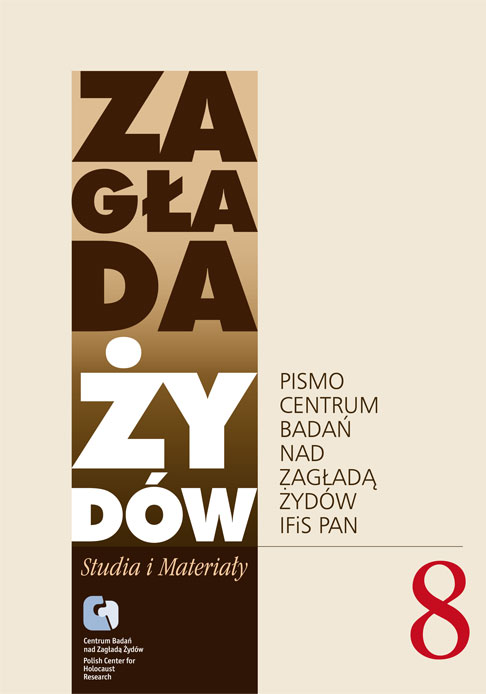O tym, co minęło, lecz nie zostało zapomniane: Badania archeologiczne na terenie byłego obozu zagłady w Treblince
Zagłada Żydów. Studia i Materiały, Nr 8 (2012), Strony: 83-118
Data zgłoszenia: 2020-10-27Data publikacji: 2012-12-02
 https://doi.org/10.32927/ZZSiM.628
https://doi.org/10.32927/ZZSiM.628
Abstrakt
Public impression of the Holocaust is unquestionably centred on knowledge about, and the image of, Auschwitz-Birkenau – the gas chambers, the crematoria, the systematic and industrialized killing of victims. Conversely, knowledge of the former extermination camp at Treblinka, which stands in stark contrast in terms of the visible evidence that survives pertaining to it, is less embedded in general public consciousness. As this paper argues, the contrasting level of knowledge about Auschwitz- Birkenau and Treblinka is centred upon the belief that physical evidence of the camps only survives when it is visible and above-ground. The perception of Treblinka as having been “destroyed” by the Nazis, and the belief that the bodies of all of the victims were cremated without trace, has resulted in a lack of investigation aimed at answering questions about the extent and nature of the camp, and the locations of mass graves and cremation pits. This paper discusses the evidence that demonstrates that traces of the camp do survive. It outlines how archival research and non-invasive archaeological survey has been used to re-evaluate the physical evidence pertaining to Treblinka in a way that respects Jewish Halacha Law. As well as facilitating spatial and temporal analysis of the former extermination camp, this survey has also revealed information about the cultural memory.
Słowa kluczowe
Treblinka , archeologia Zagłady , obóz zagłady , dowody rzeczowe , halacha
Licencja
Prawa autorskie (c) 2012 Autor&"Zagłada Żydów. Studia i Materiały"

Utwór dostępny jest na licencji Creative Commons Uznanie autorstwa 4.0 Międzynarodowe.
https://creativecommons.org/licenses/by/4.0
Czasopismo publikowane jest w standardzie Diamond Open Access na licencji CC-BY-4.0 Deed - Uznanie autorstwa 4.0 Międzynarodowa - Creative Commons
Inne teksty tego samego autora
- Caroline Sturdy Colls, Gone but not Forgotten: Archaeological approaches to the site of the former Treblinka Extermination Camp in Poland , Zagłada Żydów. Studia i Materiały: Nr Holocaust Studies and Materials (2013)
Podobne artykuły
- Redakcja, Od Redakcji , Zagłada Żydów. Studia i Materiały: Nr 13 (2017)
- Redakcja, Od Redakcji , Zagłada Żydów. Studia i Materiały: Nr 14 (2018)
- Piotr Filipkowski, Piotr M.A. Cywiński, Auschwitz. Monografia Człowieka [Piotr Filipkowski] , Zagłada Żydów. Studia i Materiały: Nr 17 (2021)
- Ewa Koźmińska-Frejlak, Joanna Nalewajko-Kulikow, Żydzi po aryjskiej stronie Warszawy, Strategie przetrwania. , Zagłada Żydów. Studia i Materiały: Nr 1 (2005)
- Katarzna Stec, Jolanta Ambrosewicz-Jacobs, Islands of Memory. The Landscape of the (Non)Memory of the Holocaust in Polish Education from 1989 to 2015 [Katarzyna Stec] , Zagłada Żydów. Studia i Materiały: Nr 17 (2021)
- Anna Ziółkowska, Dorota Sula, Żydzi polscy w Konzentrationslager Gross-Rosen [Anna Ziółkowska] , Zagłada Żydów. Studia i Materiały: Nr 17 (2021)
- Redakcja, Od Redakcji , Zagłada Żydów. Studia i Materiały: Nr 18 (2022)
- Jacek Leociak, Stanisław Śreniowski, z księgi obłędu i ohydy , Zagłada Żydów. Studia i Materiały: Nr 1 (2005)
- Marta Woźniak, “And the Earth Was Still Moving…” The Massacre of Jews in Szczeglacin in Eyewitness’ Testimonies , Zagłada Żydów. Studia i Materiały: 2010: Holocaust Studies and Materials
- Alexander Walther, Frank Bajohr, Axel Drecoll, John Lennon (red.), Dark Tourism. Reisen zu Stätten von Krieg, Massengewalt und NS-Verfolgung [Alexander Walther] , Zagłada Żydów. Studia i Materiały: Nr 17 (2021)
<< < 1 2 3 4 5 6 7 8 9 10 11 12 13 14 15 16 17 18 19 20 21 22 23 24 25 26 27 28 29 30 31 32 33 34 35 36 37 38 39 40 41 42 > >>
Możesz również Rozpocznij zaawansowane wyszukiwanie podobieństw dla tego artykułu.
 English
English
 Język Polski
Język Polski



 https://orcid.org/0000-0003-2942-6219
https://orcid.org/0000-0003-2942-6219

